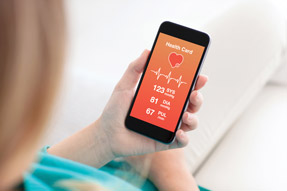Peer-led education requires strategy to be effective
Peer education, in which patients guide each other through the course of care, can be a cost-effective way of closing care gaps and encouraging patient empowerment.
Peer education, in which patients teach health information to their fellow patients who have the same conditions and similar socioeconomic or cultural backgrounds, takes planning and legwork. But those who have overseen it or studied its effects said that it can be a cost-effective way of closing gaps in care and encouraging patient empowerment, with the payoff of better management of chronic conditions like diabetes.
“Peer education becomes another level of health care delivery. We've seen how it can enhance drops in clinical values [relevant to diabetes],” said ACP Member Athena Philis-Tsimikas, MD, corporate vice president at Scripps Whittier Diabetes Institute in La Jolla, Calif. In 1997, Dr. Philis-Tsimikas assisted in establishing Project Dulce, a collaboration of health care and community-based organizations in the San Diego area that is still a vital part of health care in the communities it serves.

In a paper in the September 2011 Diabetes Care, Dr. Philis-Tsimikas and her colleagues noted the success of a Project Dulce peer-led diabetes self-management program for Mexican-Americans. Patients in an intervention group received peer education in Spanish that covered the basics of diabetes and its complications, nutrition, exercise, medication, blood glucose monitoring, and cultural beliefs that interfere with optimum self-management.
Over a 4-month period, participants in the program experienced significant improvements in their HbA1c and HDL values. These improvements held constant over 10 months, at which time participants also had improved LDL and total cholesterol levels. Meanwhile, patients in the control group, who received only standard diabetes care, had no significant changes in any of those measurements.
Culturally sensitive, peer-to-peer communication plays a large role in the program's success, Dr. Philis-Tsimikas said. “How I explain things as a clinician doesn't necessarily hit home with patients. But 1 of the beauties of peer education is that it's in their own language, by people who understand the patients' lives.”
ACP Member Jeffrey Whittle, MD, MPH, professor of medicine at the Medical College of Wisconsin and staff physician at the Zablocki VA Medical Center in Milwaukee, agreed. Dr. Whittle is co-author of a paper published in the November 2014 American Journal of Hypertension that compared peer-led self-management support to didactic seminars delivered by clinicians among veterans who were members of groups such as the American Legion, Veterans of Foreign Wars, or Vietnam Veterans of America in southeastern Wisconsin.
“It's difficult for me to give people lifestyle advice that will work in their environment,” Dr. Whittle said. “I can't give people practical, on-the-ground advice on things like where to buy food in their neighborhoods. Peers have unique lifestyle knowledge that I don't have.”
But communication is just 1 part of a program, as Dr. Whittle saw in his research: Both groups in the veterans study had similar reductions in blood pressure. He noted that the emphasis on lifestyle aspects of hypertension self-management—key points discussed in both didactic and peer-led education—and patient demographics may have played a role in the outcome.
“Hypertension might not be a good example for peer education because medications can control it pretty well even without lifestyle changes. With things like physical activity and diet, the benefit isn't instantaneous. A peer can tell patients that walking will make them feel better in 3 weeks, but in 2 weeks their knees hurt,” said Dr. Whittle. “In this population in particular, where the men are between 60 and 80 years old, patients can feel that the time for lifestyle changes was 30 years ago and don't see the benefit of changing now.”
However, the peer educators did glean some insight, Dr. Whittle added. “They got a taste of what it's like for a doctor to try to get people to make lifestyle changes. Many were quite frustrated with their peers.”
The elements of success
Designing and administering a peer-education program require enthusiasm and commitment, said Dr. Philis-Tsimikas.
“The education may be delivered by peers, but they still need some supervision. You have to have a local champion, someone dedicated to overseeing the program, maintaining quality, and reviewing new things to put into the curriculum,” Dr. Philis-Tsimikas said.
Strong recruitment for peer leaders is crucial, said Kate Lorig, DrPH, professor emeritus at Stanford University's School of Medicine and director of the Stanford Patient Education Research Center in California. The center offers small peer-led group workshops in community settings and helps people locate programs near them online.
The first step is for physicians to detach themselves from their personal preferences for their patients, Dr. Lorig said. “Don't ask your favorite patients. It's more important that they are comfortable speaking in front of other people. Some of our best leaders are not people who would be my friends.”
Dr. Lorig stressed the importance of recruiting leaders from the communities and demographics they will be working with, for example, Spanish-speaking peer leaders if the patients are Spanish-speaking or retired professionals if the patients are retired professionals.
Experience can be valuable, Dr. Lorig added. “It helps if they have some sort of leadership experience or are known in their communities.”
However, when it comes to leadership, it's possible to have too much of a good thing, said Dr. Whittle. “You want a doer, and we chose people who had leadership in their posts. But sometimes they were too comfortable with what they were doing as leaders and would introduce something that didn't have good evidence to support it. We had to discourage too much ad-libbing.”
Physicians who get involved in peer education programs should keep the legalities in mind, Dr. Whittle added. “Even though you try to tell people not to play doctor, there is a risk that some people will. If you scale that up to a large number, you run the risk of a leader providing faulty advice so someone has a bad outcome.”
According to Dr. Lorig, there are 2 key ways to avoid the pitfall of overzealous peer leaders: training and scripting. At Stanford, peer leaders have 4 days of intensive training that doubles as a screening process.
“It's like a 4-day job interview,” Dr. Lorig said. “Do they show up late? Do they dress inappropriately? Do they argue with you about minutiae? If you start with 20 potential peer leaders, you'll end up with 17 or 18.”
Dr. Lorig said that scripting the material trainees learn helps to ensure they all take the same approach. “We script content, activities, and all the peer-to-peer information in the program. We teach them how to do that specific course the way it's supposed to be done.”
Scripting also helps peer leaders know their roles, she added. “A common reason peer interventions fail is that they put too much burden on the peer leaders. They say, ‘Okay, you're trained, go find a place to teach and then recruit everyone.’ We expect leaders to show up and teach, not do other stuff.”
Reaching out
The most thoroughly trained peer educators aren't going to be much help if no one enrolls in the programs, so outreach is key, said Dr. Philis-Tsimikas. “Go wherever people are already congregating—senior centers, community YMCAs, community clinics. Getting them to come to you isn't going to work.”
Ian M. Kronish, MD, MPH, assistant professor in the division of general medicine at Columbia University Medical Center in New York, can attest to that. Dr. Kronish is co-author of a paper in the November 2014 Stroke that detailed the effect of peer education on secondary stroke prevention in black and Latino stroke survivors. Patients in the peer-led intervention group had greater improvements in their systolic blood pressure at 6 months than those in the control group.
There was some suspicion in the community of the big academic medical center, so not having the meetings at the hospital, but rather in community centers, was key to success. “Otherwise, patients might have been less willing to commit to the program,” Dr. Kronish said.
Peer education in the community may also help patients feel comfortable enough to open up and talk about their challenges, especially after an acute illness like stroke, Dr. Kronish added. “A lot of people don't like to talk about strokes because they're worried people will treat them differently. When our patients came together, there seemed to be a bonding. For a lot of them, it was the first time they spoke of their strokes.”
Dr. Kronish feels that the experience of working with peer education groups can give physicians a fresh outlook on providing care.
“Patients will tell you different things in different contexts,” Dr. Kronish said. “With peer leaders, you see more eye-to-eye, at an equal level, and you can get insight into what matters most to patients. It enriched the project and helped us succeed in reaching people and getting them to participate.”
Getting involved
The experts agree that physicians who wish to get involved in peer education programs should be prepared to go above and beyond, because the finances can be a challenge.
At Project Dulce, funding was the biggest hurdle, said Dr. Philis-Tsimikas. The program was funded by grants, and the county of San Diego adopted it as a method of delivering diabetes education in community health centers, going so far as to reimburse for it on a fee-for-service system.
Things changed with the Affordable Care Act, Dr. Philis-Tsimikas said. “The county had to adopt Medicaid rules with the ACA, and Medicaid does not cover diabetes education, so it became a lot harder in the last few years. [Only] 7 or 8 community health centers figured out other ways to maintain the program.”
Physicians in small group practices would most likely have to connect with programs through a health system, Dr. Philis-Tsimikas said. “It's tough for physicians in private practice because of the training required. But they may be able to partner with larger organizations who provide these programs as a service they can tap into.”
“There is no real incentive to provide peer education programs from a financial point of view unless you are part of a health system that invests in peer supporters. This really has to be viewed as part of our jobs as physicians to help make people feel better,” Dr. Whittle said, stressing that involvement is a valuable way to be of service to the community.
“Physicians have the gift of being powerful, influential people, and talking to 10 peer educators to get them engaged will have more of an impact than giving a general talk to 100 people in an auditorium,” he said. “Job satisfaction may be the only payoff you get, but the relationship you develop with selfless volunteers who want to help others is very gratifying.”





